Responses of Sediment Yield to Vegetation Cover Changes in the Poyang Lake Drainage Area, China
Abstract
:1. Introduction
2. Study Area and Data
2.1. Study Area Description
2.2. Data Sources and Processes
2.2.1. Rainfall Erosivity and Sediment Yield Data
2.2.2. Remote Sensing Products
3. Methodology
3.1. The “Source-Sink Theory” of Sediment Transport
3.2. Determination of the “Source” and “Sink” Patches
3.3. Description of the Topographical-Related Spatial Patterns of “Source” and “Sink”
3.4. Location-weighted landscape contrast index
3.5. A modified Topographic Index
4. Results
4.1. Temporal and Spatial Variations in Vegetation Covers
4.2. LCI/mLCI Analysis in the Five Watersheds
4.3. The mLCIs of the Sub-Watersheds of the Ganjiang Watershed
5. Discussion
6. Conclusions
Acknowledgments
Author Contributions
Conflicts of Interest
References
- Singha, R.; Tiwarib, K.N.; Malb, B.C. Hydrological studies for small watershed in India using the ANSWERS model. J. Hydrol. 2006, 318, 184–199. [Google Scholar] [CrossRef]
- Xi, H.Y.; Wang, S.R.; Zheng, B.H. Ecological security evolvement in Poyang Lake influenced by basin human activity. Res. Environ. Sci. 2014, 27, 398–405. [Google Scholar]
- Ma, L.; Jiang, G.H.; Zuo, C.Q.; Qiu, G.Y.; Huo, H.G. Spatial and temporal distribution characteristics of rainfall erosivity changes in Jiangxi province over more than 50 years. Trans. CSAE 2009, 25, 61–68. (In Chinese) [Google Scholar]
- Tang, X.Y.; Yang, H.; Cao, H.; Zhao, Q.G.; Li, R.Y. Preliminary Estimate of Soil Erosion Rate in Haplic Red Soil in Southern China Using 137Cs Technique. J. Soil Water Conserv. 2001, 15, 4–11. (In Chinese) [Google Scholar]
- Liang, Y.; Yang, X.; Su, C.L.; Sun, B.; Pan, X.Z. EI-based analysis of variation and trends of soil erosion of red soil region on a county scale. Acta Pedolog. Ica Sin. 2009, 46, 24–29. (In Chinese) [Google Scholar]
- Xie, S.H.; Zeng, J.L.; Yand, J. Overall situation of water and soil loss in Jiangxi Province. J. Nanchang Inst. Technol. 2010, 29, 69–72. [Google Scholar]
- Fan, Z.W.; Huang, L.G.; Qian, H.Y.; Fang, Y. Soil erosion effects driven by land use changes over the Poyang Lake Basin. Resour. Sci. 2009, 31, 1787–1792. (In Chinese) [Google Scholar]
- Chen, L.D.; Fu, B.J.; Xu, J.Y.; Gong, J. Location-weighted landscape contrast index: A scale independent approach for landscape pattern evaluation based on “source–sink” ecological processes. Acta Ecol. Sin. 2003, 23, 2406–2413. (In Chinese) [Google Scholar]
- Bautista, S.; Mayor, A.G.; Bourakhouadar, J.; Bellot, J. Plant spatial pattern predicts hillslope runoff and erosion in a semiarid Mediterranean landscape. Ecosystems 2007, 10, 987–998. [Google Scholar] [CrossRef]
- Shi, Z.H.; Ai, L.; Li, X.; Huang, X.D.; Wua, G.L.; Liao, W. Partial least-squares regression for linking land-cover patterns to soil erosion and sediment yield in watersheds. J. Hydrol. 2013, 498, 165–176. [Google Scholar] [CrossRef]
- Davenport, D.W.; Breshears, D.D.; Wilcox, B.P.; Allen, C.D. Viewpoint: Sustainability of pinyon-juniper ecosystems a unifying perspective of soil erosion thresholds. J. Range Manag. 1998, 51, 231–240. [Google Scholar] [CrossRef]
- Puigdefábregas, J. The role of vegetation patterns in structuring runoff and sediment fluxes in drylands. Earth Surf. Process. Landf. 2005, 30, 133–147. [Google Scholar] [CrossRef]
- Deng, L.; Shangguan, Z.P.; LI, R. Effects of the grain-for-green program on soil erosion in China. Int. J. Sediment Res. 2012, 27, 120–127. [Google Scholar] [CrossRef]
- Ludwig, J.A.; Tongway, D.J. Spatial organisation of landscapes and its function in semi-arid woodlands, Australia. Landsc. Ecol. 1995, 10, 51–63. [Google Scholar] [CrossRef]
- Cammeraat, L.H.; Imeson, A.C. The evolution and significance of soil-vegetation patterns following land abandonment and fire in Spain. Catena 1999, 37, 107–127. [Google Scholar] [CrossRef]
- Ludwig, J.A.; Bastin, G.N.; Chewings, V.H.; Eager, R.W.; Liedloff, A.C. Leakiness: A new index for monitoring the health of arid and semiarid landscapes using remotely sensed vegetation cover and elevation data. Ecol. Indic. 2007, 7, 442–454. [Google Scholar] [CrossRef]
- Ludwig, J.A.; Eager, R.W.; Bastin, G.N.; Chewings, V.H.; Liedloff, A.C. A leakiness index for assessing landscape function using remote sensing. Landsc. Ecol. 2002, 17, 157–171. [Google Scholar] [CrossRef]
- Ludwig, J.A.; Eager, R.W.; Liedloff, A.C.; Bastin, G.N.; Chewings, V.H. A new landscape leakiness index based on remotely sensed ground-cover data. Ecol. Indic. 2006, 6, 327–336. [Google Scholar] [CrossRef]
- Buck, O.; Niyogi, D.K.; Townsend, C.R. Scale-dependence of land use effects on water quality of streams in agricultural catchments. Environ. Pollut. 2004, 130, 287–299. [Google Scholar] [CrossRef] [PubMed]
- Fu, B.J.; Liang, D.; Lu, N. Landscape ecology: Coupling of pattern, process, and scale. Chin. Geogr. Sci. 2011, 21, 385–391. [Google Scholar] [CrossRef]
- Casermeiro, M.A.; Molina, J.A.; de la Cruz Caravaca, M.T.; Hernando Costa, J.; HernandoMassanet, M.I.; Moreno, P.S. Influence of scrubs on runoff and sediment lossin soils of Mediterranean climate. Catena 2004, 57, 91–107. [Google Scholar] [CrossRef]
- Fridley, J.D.; Stachowicz, J.J.; Naeem, S.; Sax, D.F.; Seabloom, E.W.; Smith, M.D.; Stohlgren, T.J.; Tilman, D.; Von Holle, B. The invasion paradox: Reconciling pattern and process in species invasions. Ecology 2007, 88, 3–17. [Google Scholar] [CrossRef]
- Bisigato, A.J.; Villagra, P.E.; Ares, J.O.; Rossi, B.E. Vegetation heterogeneity in Monte Desert ecosystems: A multi-scale approach linking patterns and processes. J. Arid Environ. 2009, 73, 182–191. [Google Scholar] [CrossRef]
- Borselli, L.; Cassi, P.; Torri, D. Prolegomena to sediment and flow connectivity in the landscape: A GIS and field. Catena 2008, 75, 268–277. [Google Scholar] [CrossRef]
- Mayor, A.G.; Bautista, S.; Small, E.E.; Dixon, M.; Bellot, J. Measurement of the connectivity of runoff source areas as determined by vegetation pattern and topography: A tool for assessing potential water and soil losses in drylands. Water Resour. Res. 2008, 44. [Google Scholar] [CrossRef]
- Chen, L.D.; Fu, B.J.; Zhao, W.W. Source-sink landscape theory and its ecological significance. Front. Biol. China 2008, 3, 131–136. [Google Scholar] [CrossRef]
- Imeson, A.C.; Prinsen, H.A.M. Vegetation patterns as biological indicators for identifying runoff and sediment sources and sink areas for semi-arid landscape in Spain. Agric. Ecosyst. Environ. 2004, 104, 333–342. [Google Scholar] [CrossRef]
- Li, J.; Zhou, Z.X. Coupled analysis on landscape pattern and hydrological processes in Yanhe watershed of China. Sci. Total Environ. 2015, 505, 927–938. [Google Scholar] [CrossRef] [PubMed]
- Jiang, M.Z.; Chen, H.Y.; Chen, Q.H. A method to analyze “source–sink” structure of non-point source pollution based on remote sensing technology. Environ. Pollut. 2013, 182, 135–140. [Google Scholar] [CrossRef] [PubMed]
- Yue, J.; Wang, Y.L.; Li, G.C.; Wu, J.S.; Xie, M.M. The influence of landscape spatial difference on water quality at differing scales: A case study of Xili reservoir watershed in Shenzhen city. Acta Ecol. Sin. 2007, 27, 5271–5282. (In Chinese) [Google Scholar]
- Liu, F.; Shen, Z.Y.; Liu, R.M. The agricultural non-point sources pollution in the upper reaches of the Yangtze River based on sources-sink ecological process. Acta Ecol. Sin. 2009, 29, 3271–3277. (In Chinese) [Google Scholar]
- Sanchez-Moreno, J.F.; Mannaerts, C.M.; Jetten, V. Rainfall erosivity mapping for Santiago Island, Cape Verde. Geoderma 2014, 217–218, 74–82. [Google Scholar] [CrossRef]
- Xiao, L.L.; Yang, X.H.; Chen, S.X.; Cai, H.Y. An assessment of erosivity distribution and its influence on the effectiveness of land use conversion for reducing soil erosion in Jiangxi, China. Catena 2015, 125, 50–60. [Google Scholar] [CrossRef]
- Changjiang Water Resources Commission. Changjiang Sediment Bulletin; Changjiang Water Resources Commission: Wuhan, China, 2004; pp. 6–7. [Google Scholar]
- Changjiang Water Resources Commission. Changjiang Sediment Bulletin; Changjiang Water Resources Commission: Wuhan, China, 2005; pp. 6–7. [Google Scholar]
- Changjiang Water Resources Commission. Changjiang Sediment Bulletin; Changjiang Water Resources Commission: Wuhan, China, 2006; pp. 9–10. [Google Scholar]
- Changjiang Water Resources Commission. Changjiang Sediment Bulletin; Changjiang Water Resources Commission: Wuhan, China, 2011; pp. 11–12. [Google Scholar]
- Changjiang Water Resources Commission. Changjiang Sediment Bulletin; Changjiang Water Resources Commission: Wuhan, China, 2012; pp. 11–13. [Google Scholar]
- Changjiang Water Resources Commission. Changjiang Sediment Bulletin; Changjiang Water Resources Commission: Wuhan, China, 2013; pp. 10–12. [Google Scholar]
- Sun, P.; Zhang, Q.; Chen, X.H.; Chen, Y.Q. Spatio-temporal Patterns of Sediment and Runoff Changes in the Poyang Lake Basin and Underlying Causes. Acta Geogr. Sin. 2010, 65, 828–840. [Google Scholar]
- Miao, Z.H.; Liu, Z.M.; Wang, Z.M.; Song, K.S.; Du, J.; Zheng, L.H. Dynamic monitoring of vegetation fraction change in Jilin province based on Modis NDVI. Remote Sens. Technol. Appl. 2010, 25, 387–393. [Google Scholar]
- Kateb, H.E.; Zhang, H.F.; Zhang, P.C.; Mosandl, R. Soil erosion and surface runoff on different vegetation covers and slope gradients: A field experiment in Southern Shaanxi Province, China. Catena 2013, 105, 1–10. [Google Scholar] [CrossRef]
- Yuan, J.P.; Jiang, D.S.; Gan, S. Simulated experiment on normal integral model of different control degrees for small watershed. J. Nat. Resour. 2000, 6, 91–96. (In Chinese) [Google Scholar]
- Wu, Q.X.; Zhao, H.Y.; Han, B. Benefit and characteristics of grass–shrub vegetation for reducing soil erosion in loess hilly region. Acta Agrestia Sin. 2003, 11, 23–26. (In Chinese) [Google Scholar]
- Feng, X.M.; Wang, Y.F.; Chen, L.D.; Fu, B.J.; Bai, G.S. Modeling soil erosion and its response to land-use change in hilly catchments of the Chinese Loess Plateau. Geomorphology 2010, 118, 239–248. [Google Scholar] [CrossRef]
- Bakker, M.M.; Govers, G.; Doorn, A.V.; Quetier, F.; Chouvardas, D.; Rounsevell, M. The response of soil erosion and sediment export to land-use change in four areas of Europe: The importance of landscape pattern. Geomorphology 2008, 98, 213–226. [Google Scholar] [CrossRef]
- Lu, A.G.; Zhang, L.; Suo, A. Method of landscape pattern analysis based on soil and water loss process. Ecol. Environ. Sci. 2010, 19, 1599–1604. (In Chinese) [Google Scholar]
- Wang, W.Z.; Jiao, J.Y. Quantitative evaluation on factors influencing soil erosion in China. Bull. Soil Water Conserv. 1996, 5, 1–20. (In Chinese) [Google Scholar]
- Liu, B.Y.; Xie, Y.; Zhang, K.L. Soil Erosion Prediction Model; Science and Technology of China Press: Beijing, China, 2001. (In Chinese) [Google Scholar]
- Yang, M.; Li, X.Z.; Yang, Z.P.; Hu, Y.M.; Wen, Q.C. Effects of sub-watershed landscape patterns at the upper reaches of Minjinag River on soil erosion. Chin. J. Appl. Ecol. 2007, 18, 2512–2519. [Google Scholar]
- Song, W.; Pijanowski, B.C. The effects of China’s cultivated land balance program on potential land productivity at a national scale. Appl. Geogr. 2014, 46, 158–170. [Google Scholar] [CrossRef]
- Xiao, L.L.; Yang, X.H.; Cai, H.Y.; Zhang, D.X. Cultivated land changes and agricultural potential productivity in Mainland China. Sustainability 2015, 7, 11893–11908. [Google Scholar] [CrossRef]


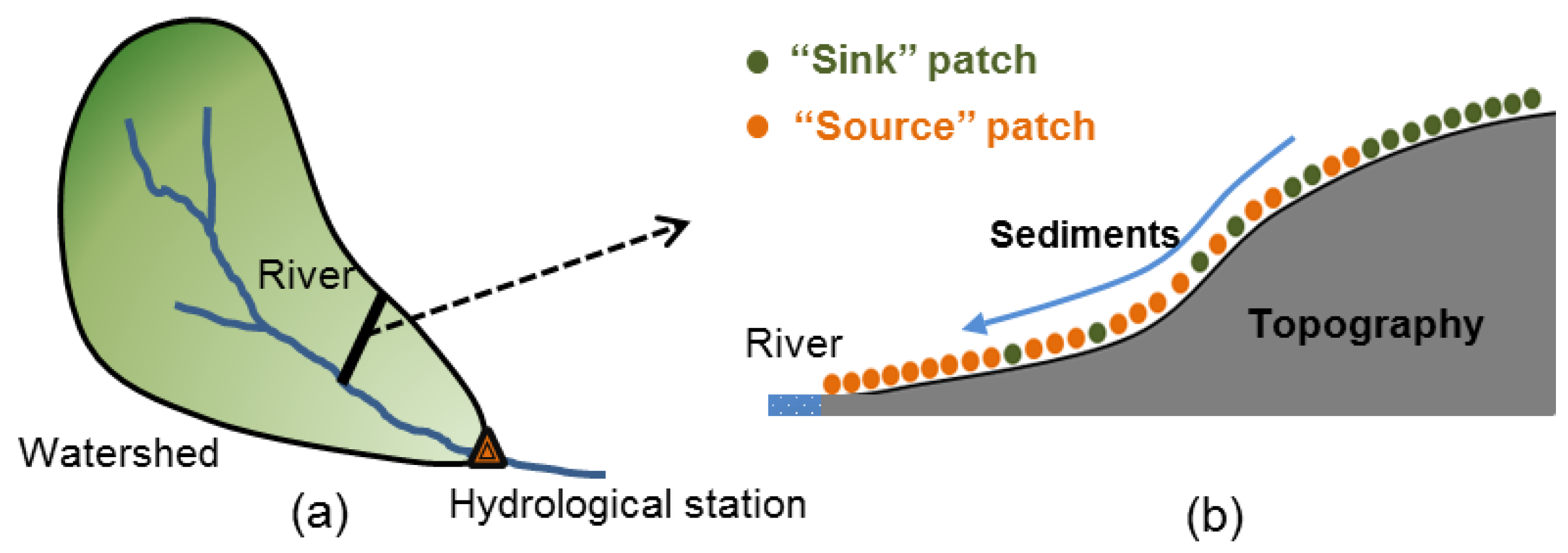
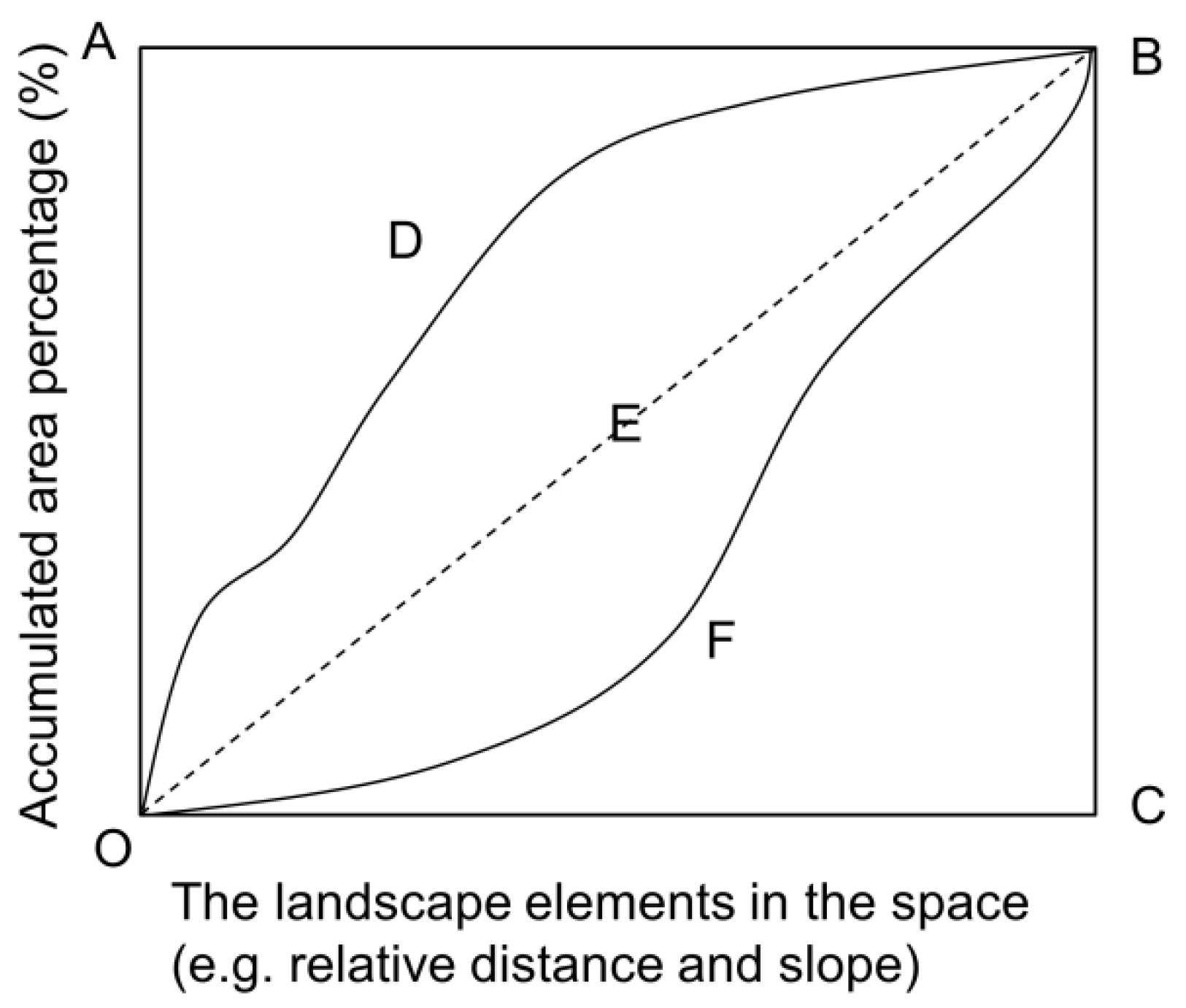
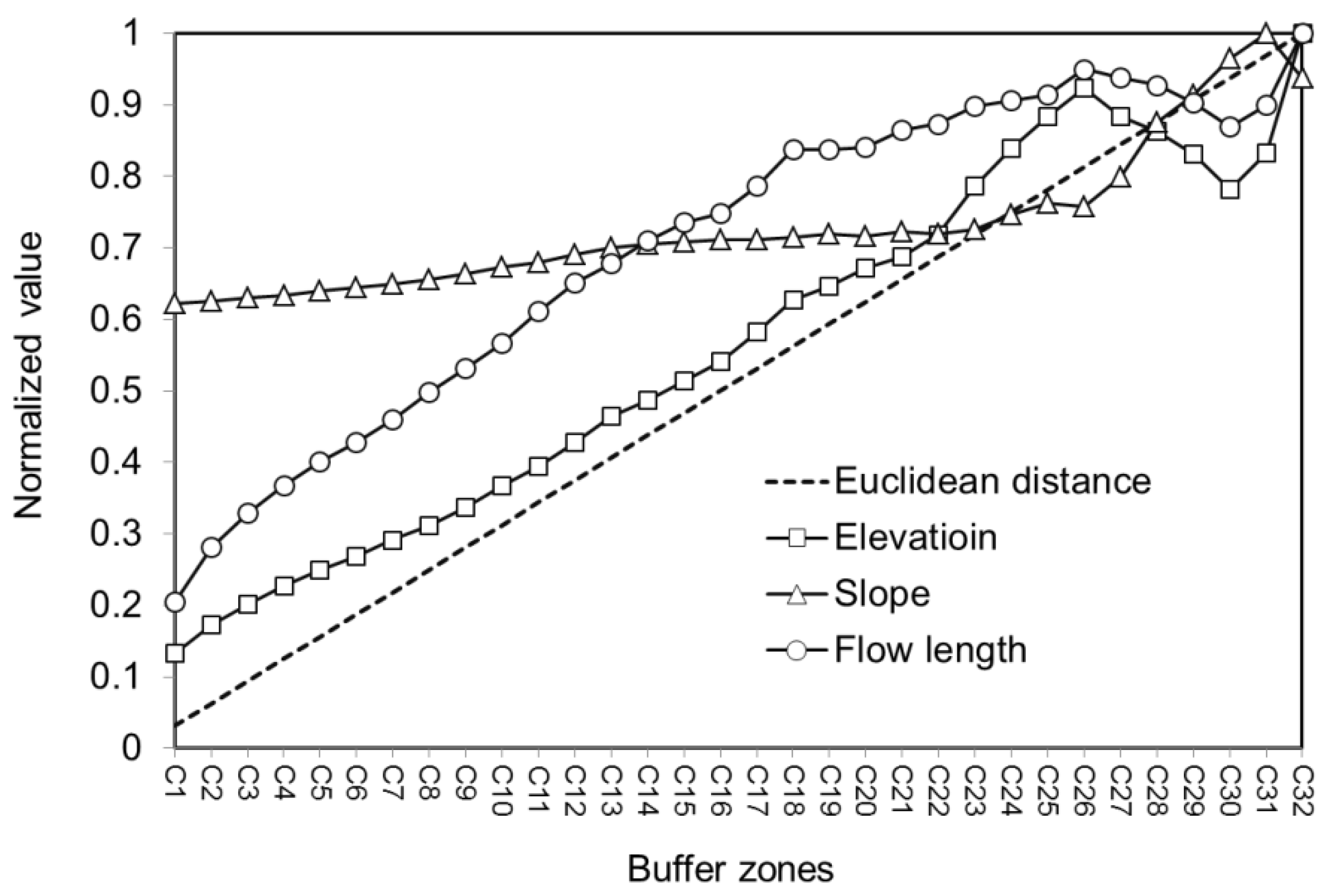
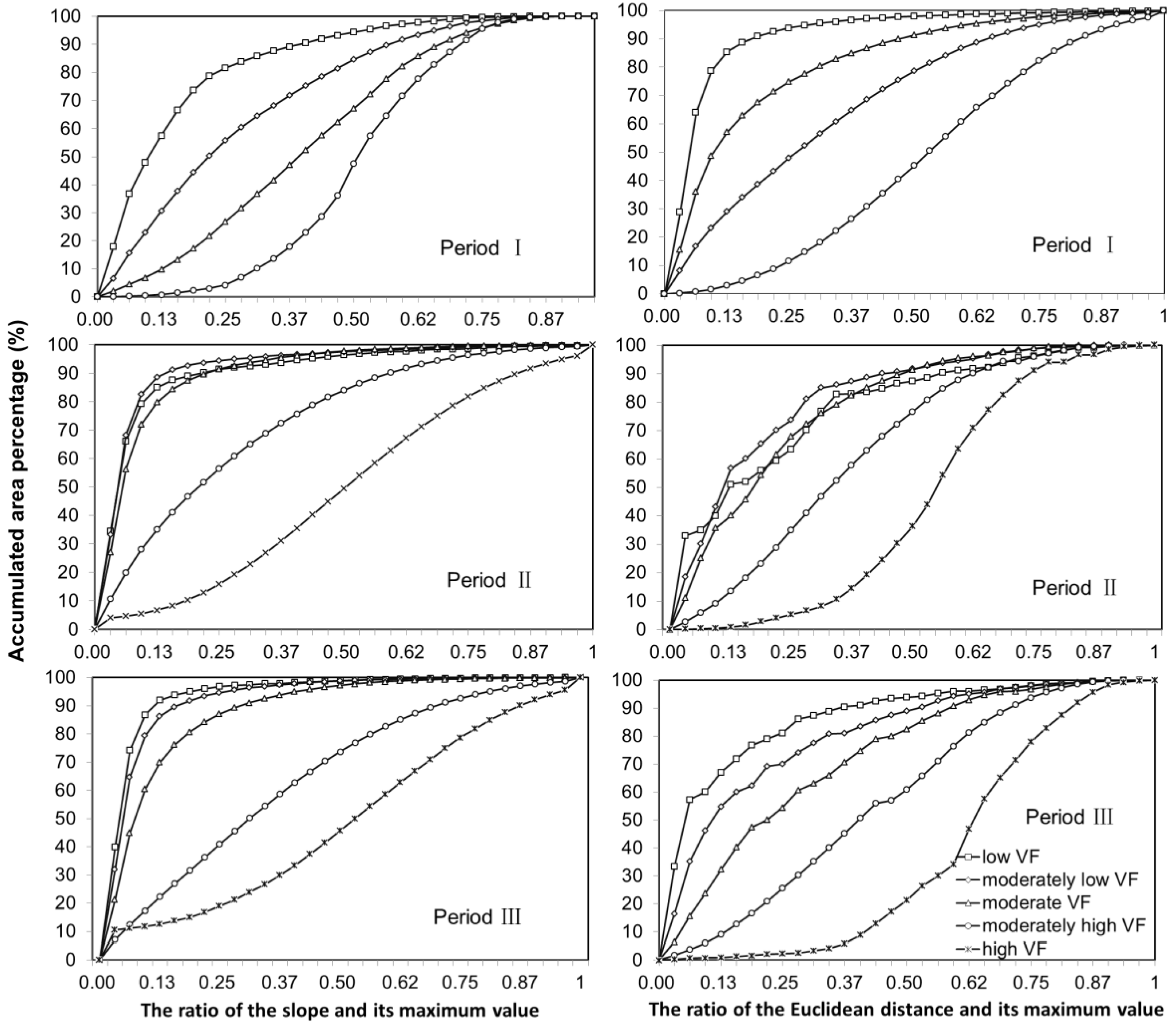
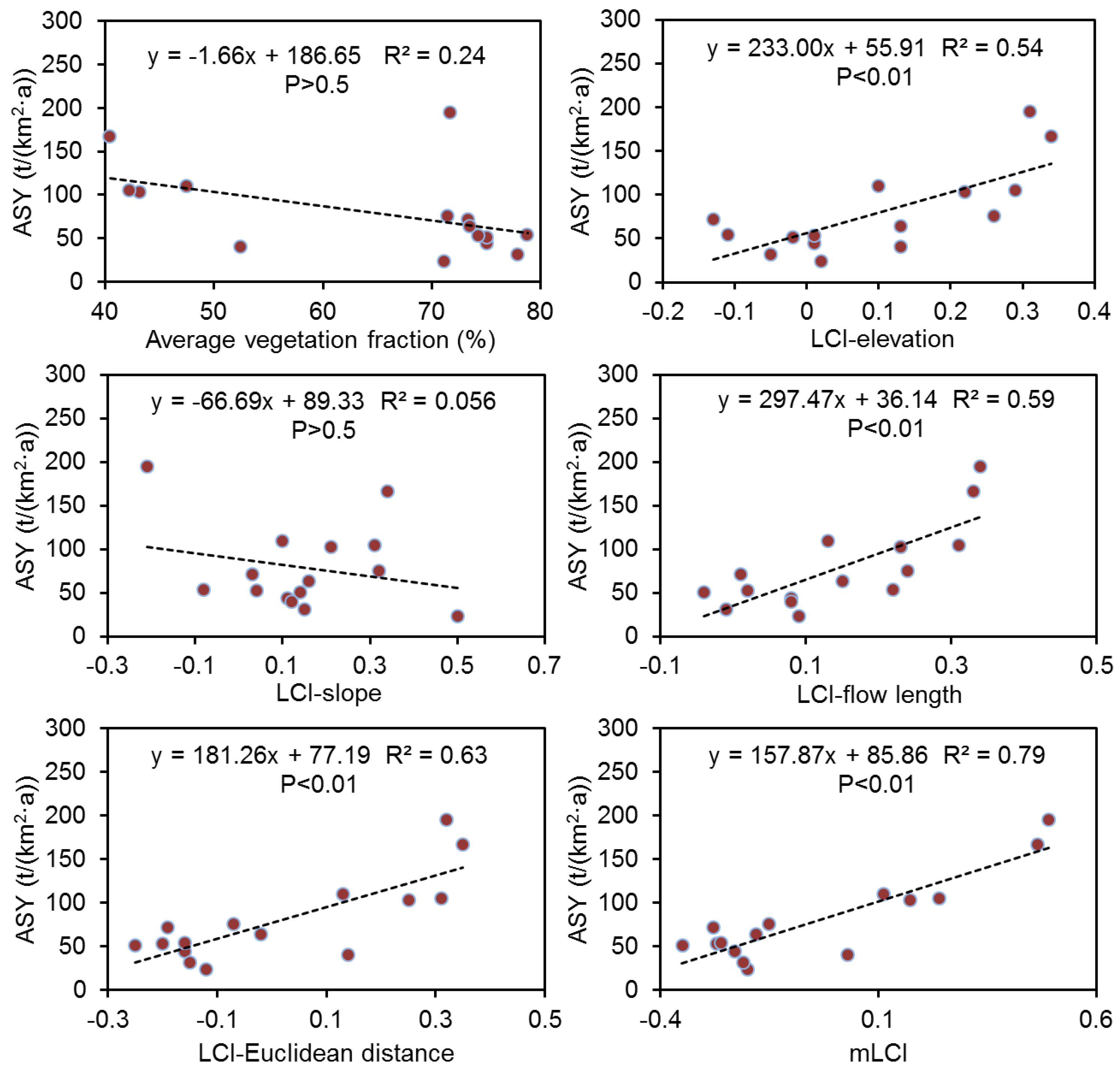
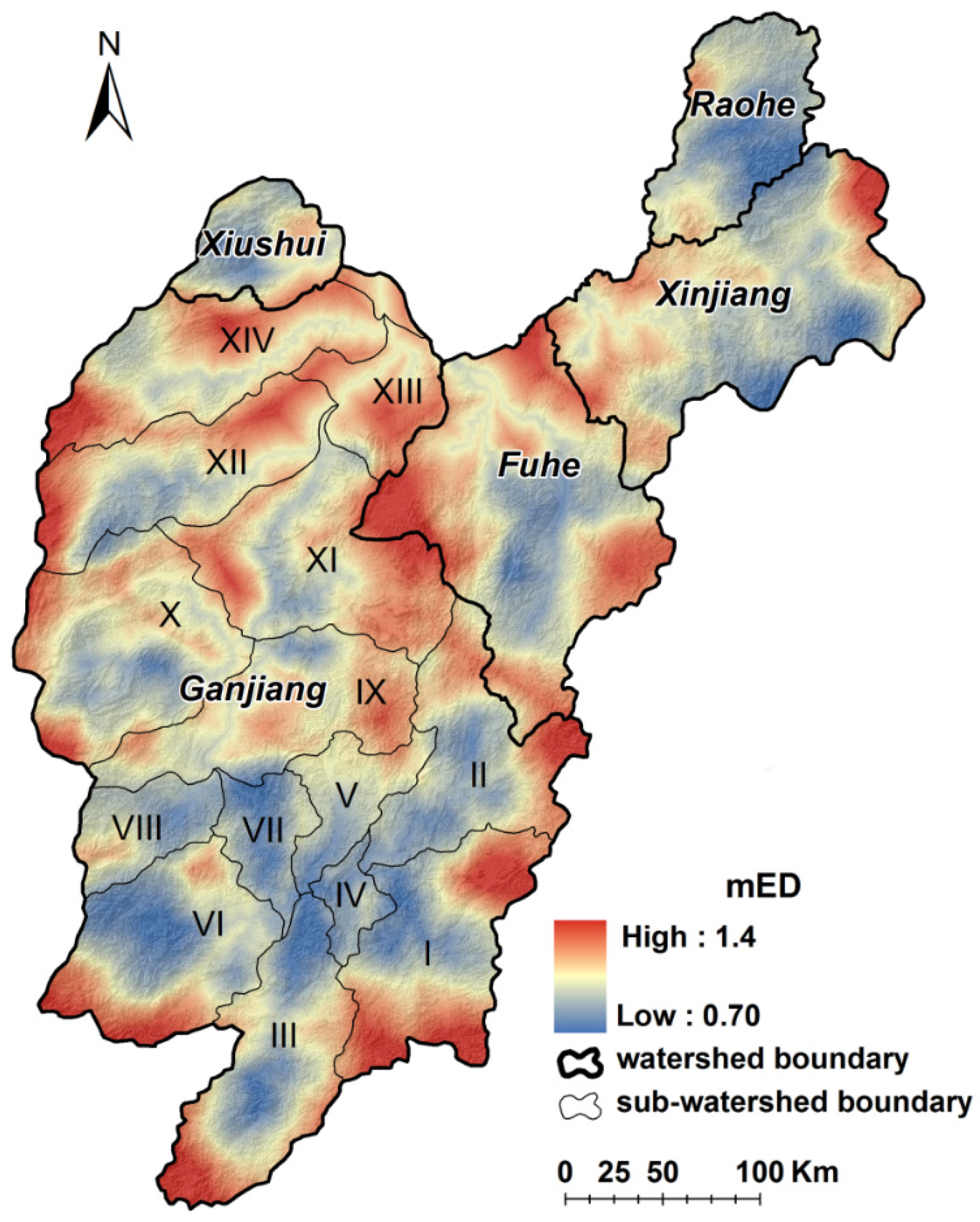
| Watershed | Hydrological Stations | Watershed Area (×104 km2) | Period I (1992–1994) | Period II (2004–2006) | Period III (2011–2013) | |||
|---|---|---|---|---|---|---|---|---|
| ASY | R | ASY | R | ASY | R | |||
| Ganjiang | Waizhou | 8.09 | 103.4 | 10,252.9 | 44.62 | 10,112.5 | 23.82 | 9859.6 |
| Fuhe | Lijiadu | 1.58 | 105.5 | 10,225.3 | 51.05 | 11,260.1 | 72.09 | 10,195.3 |
| Xinjiang | Meigang | 1.55 | 167.7 | 11,671.6 | 53.18 | 10,852.0 | 75.94 | 10,686.4 |
| Raohe | Hushan | 0.64 | 40.6 | 11,852.6 | 31.56 | 10,210.5 | 195.68 | 12,250.8 |
| Xiushui | Wanjiabu | 0.35 | 110.4 | 10,525.9 | 54.19 | 9999.7 | 63.71 | 10,029.1 |
| Watershed | Period | VF Levels | ||||
|---|---|---|---|---|---|---|
| Low | Moderately Low | Moderate | Moderately High | High | ||
| Ganjiang | I | 7.55 | 23.1 | 59.23 | 10.04 | 0.08 |
| II | 1.54 | 5.2 | 23.02 | 53.32 | 16.92 | |
| III | 2.52 | 5.95 | 24.21 | 57.98 | 9.34 | |
| Fuhe | I | 7.81 | 25.29 | 61.05 | 5.79 | 0 |
| II | 1.17 | 3.52 | 20.34 | 61.94 | 13.04 | |
| III | 2.42 | 5.52 | 25.02 | 63.37 | 3.68 | |
| Xinjiang | I | 9.53 | 27.05 | 60.18 | 3.24 | 0.01 |
| II | 1.2 | 4.05 | 18.23 | 55.50 | 21.01 | |
| III | 2.21 | 7.04 | 29.3 | 56.02 | 5.4 | |
| Raohe | I | 2.53 | 5.46 | 35.94 | 45.85 | 10.22 |
| II | 0.5 | 0.9 | 8.34 | 58.46 | 31.72 | |
| III | 1.28 | 13.67 | 25.25 | 46.56 | 13.24 | |
| Xiushui | I | 2.05 | 14.62 | 37.45 | 45.03 | 0.85 |
| II | 1.01 | 3.02 | 15.51 | 46.01 | 34.85 | |
| III | 1.4 | 6.01 | 25.37 | 56.6 | 10.62 | |
| Code | Sub-Watershed Name | mLCIs | ||
|---|---|---|---|---|
| Period I | Period II | Period III | ||
| I | Lian-Mian | 0.08 | −0.31 | −0.34 |
| II | Meijiang | 0.16 | −0.27 | −0.38 |
| III | Taojiang | 0.15 | −0.22 | −0.31 |
| IV | Gongshui | 0.11 | −0.26 | −0.27 |
| V | Pingjiang | 0.24 | −0.15 | −0.24 |
| VI | Shangyou-Zhangshui | 0.16 | −0.27 | −0.28 |
| VII | Upper-Ganliu | 0.22 | −0.24 | −0.30 |
| VIII | Suichuanjiang | 0.14 | −0.66 | −0.45 |
| IX | Longjiang | 0.23 | −0.32 | −0.3 |
| X | Lu-He | 0.05 | −0.31 | −0.29 |
| XI | Enjiang | 0.24 | −0.24 | −0.22 |
| XII | Yuanhe | 0.23 | −0.28 | −0.06 |
| XIII | Qingfengshan | 0.45 | −0.07 | 0.04 |
| XIV | Jinjiang | 0.17 | −0.22 | −0.06 |
© 2016 by the authors; licensee MDPI, Basel, Switzerland. This article is an open access article distributed under the terms and conditions of the Creative Commons by Attribution (CC-BY) license (http://creativecommons.org/licenses/by/4.0/).
Share and Cite
Xiao, L.; Yang, X.; Cai, H. Responses of Sediment Yield to Vegetation Cover Changes in the Poyang Lake Drainage Area, China. Water 2016, 8, 114. https://doi.org/10.3390/w8040114
Xiao L, Yang X, Cai H. Responses of Sediment Yield to Vegetation Cover Changes in the Poyang Lake Drainage Area, China. Water. 2016; 8(4):114. https://doi.org/10.3390/w8040114
Chicago/Turabian StyleXiao, Linlin, Xiaohuan Yang, and Hongyan Cai. 2016. "Responses of Sediment Yield to Vegetation Cover Changes in the Poyang Lake Drainage Area, China" Water 8, no. 4: 114. https://doi.org/10.3390/w8040114
APA StyleXiao, L., Yang, X., & Cai, H. (2016). Responses of Sediment Yield to Vegetation Cover Changes in the Poyang Lake Drainage Area, China. Water, 8(4), 114. https://doi.org/10.3390/w8040114






